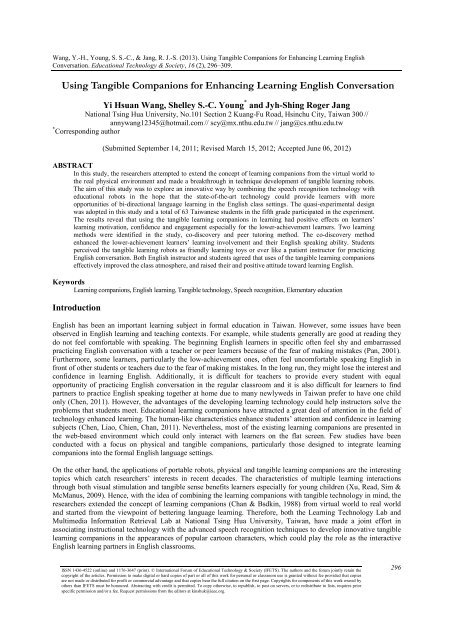Download Complete Issue in PDF - Educational Technology & Society
Download Complete Issue in PDF - Educational Technology & Society
Download Complete Issue in PDF - Educational Technology & Society
You also want an ePaper? Increase the reach of your titles
YUMPU automatically turns print PDFs into web optimized ePapers that Google loves.
Wang, Y.-H., Young, S. S.-C., & Jang, R. J.-S. (2013). Us<strong>in</strong>g Tangible Companions for Enhanc<strong>in</strong>g Learn<strong>in</strong>g English<br />
Conversation. <strong>Educational</strong> <strong>Technology</strong> & <strong>Society</strong>, 16 (2), 296–309.<br />
Us<strong>in</strong>g Tangible Companions for Enhanc<strong>in</strong>g Learn<strong>in</strong>g English Conversation<br />
Yi Hsuan Wang, Shelley S.-C. Young * and Jyh-Sh<strong>in</strong>g Roger Jang<br />
National Ts<strong>in</strong>g Hua University, No.101 Section 2 Kuang-Fu Road, Hs<strong>in</strong>chu City, Taiwan 300 //<br />
annywang12345@hotmail.com // scy@mx.nthu.edu.tw // jang@cs.nthu.edu.tw<br />
* Correspond<strong>in</strong>g author<br />
(Submitted September 14, 2011; Revised March 15, 2012; Accepted June 06, 2012)<br />
ABSTRACT<br />
In this study, the researchers attempted to extend the concept of learn<strong>in</strong>g companions from the virtual world to<br />
the real physical environment and made a breakthrough <strong>in</strong> technique development of tangible learn<strong>in</strong>g robots.<br />
The aim of this study was to explore an <strong>in</strong>novative way by comb<strong>in</strong><strong>in</strong>g the speech recognition technology with<br />
educational robots <strong>in</strong> the hope that the state-of-the-art technology could provide learners with more<br />
opportunities of bi-directional language learn<strong>in</strong>g <strong>in</strong> the English class sett<strong>in</strong>gs. The quasi-experimental design<br />
was adopted <strong>in</strong> this study and a total of 63 Taiwanese students <strong>in</strong> the fifth grade participated <strong>in</strong> the experiment.<br />
The results reveal that us<strong>in</strong>g the tangible learn<strong>in</strong>g companions <strong>in</strong> learn<strong>in</strong>g had positive effects on learners’<br />
learn<strong>in</strong>g motivation, confidence and engagement especially for the lower-achievement learners. Two learn<strong>in</strong>g<br />
methods were identified <strong>in</strong> the study, co-discovery and peer tutor<strong>in</strong>g method. The co-discovery method<br />
enhanced the lower-achievement learners’ learn<strong>in</strong>g <strong>in</strong>volvement and their English speak<strong>in</strong>g ability. Students<br />
perceived the tangible learn<strong>in</strong>g robots as friendly learn<strong>in</strong>g toys or ever like a patient <strong>in</strong>structor for practic<strong>in</strong>g<br />
English conversation. Both English <strong>in</strong>structor and students agreed that uses of the tangible learn<strong>in</strong>g companions<br />
effectively improved the class atmosphere, and raised their and positive attitude toward learn<strong>in</strong>g English.<br />
Keywords<br />
Learn<strong>in</strong>g companions, English learn<strong>in</strong>g, Tangible technology, Speech recognition, Elementary education<br />
Introduction<br />
English has been an important learn<strong>in</strong>g subject <strong>in</strong> formal education <strong>in</strong> Taiwan. However, some issues have been<br />
observed <strong>in</strong> English learn<strong>in</strong>g and teach<strong>in</strong>g contexts. For example, while students generally are good at read<strong>in</strong>g they<br />
do not feel comfortable with speak<strong>in</strong>g. The beg<strong>in</strong>n<strong>in</strong>g English learners <strong>in</strong> specific often feel shy and embarrassed<br />
practic<strong>in</strong>g English conversation with a teacher or peer learners because of the fear of mak<strong>in</strong>g mistakes (Pan, 2001).<br />
Furthermore, some learners, particularly the low-achievement ones, often feel uncomfortable speak<strong>in</strong>g English <strong>in</strong><br />
front of other students or teachers due to the fear of mak<strong>in</strong>g mistakes. In the long run, they might lose the <strong>in</strong>terest and<br />
confidence <strong>in</strong> learn<strong>in</strong>g English. Additionally, it is difficult for teachers to provide every student with equal<br />
opportunity of practic<strong>in</strong>g English conversation <strong>in</strong> the regular classroom and it is also difficult for learners to f<strong>in</strong>d<br />
partners to practice English speak<strong>in</strong>g together at home due to many newlyweds <strong>in</strong> Taiwan prefer to have one child<br />
only (Chen, 2011). However, the advantages of the develop<strong>in</strong>g learn<strong>in</strong>g technology could help <strong>in</strong>structors solve the<br />
problems that students meet. <strong>Educational</strong> learn<strong>in</strong>g companions have attracted a great deal of attention <strong>in</strong> the field of<br />
technology enhanced learn<strong>in</strong>g. The human-like characteristics enhance students’ attention and confidence <strong>in</strong> learn<strong>in</strong>g<br />
subjects (Chen, Liao, Chien, Chan, 2011). Nevertheless, most of the exist<strong>in</strong>g learn<strong>in</strong>g companions are presented <strong>in</strong><br />
the web-based environment which could only <strong>in</strong>teract with learners on the flat screen. Few studies have been<br />
conducted with a focus on physical and tangible companions, particularly those designed to <strong>in</strong>tegrate learn<strong>in</strong>g<br />
companions <strong>in</strong>to the formal English language sett<strong>in</strong>gs.<br />
On the other hand, the applications of portable robots, physical and tangible learn<strong>in</strong>g companions are the <strong>in</strong>terest<strong>in</strong>g<br />
topics which catch researchers’ <strong>in</strong>terests <strong>in</strong> recent decades. The characteristics of multiple learn<strong>in</strong>g <strong>in</strong>teractions<br />
through both visual stimulation and tangible sense benefits learners especially for young children (Xu, Read, Sim &<br />
McManus, 2009). Hence, with the idea of comb<strong>in</strong><strong>in</strong>g the learn<strong>in</strong>g companions with tangible technology <strong>in</strong> m<strong>in</strong>d, the<br />
researchers extended the concept of learn<strong>in</strong>g companions (Chan & Bsdk<strong>in</strong>, 1988) from virtual world to real world<br />
and started from the viewpo<strong>in</strong>t of better<strong>in</strong>g language learn<strong>in</strong>g. Therefore, both the Learn<strong>in</strong>g <strong>Technology</strong> Lab and<br />
Multimedia Information Retrieval Lab at National Ts<strong>in</strong>g Hua University, Taiwan, have made a jo<strong>in</strong>t effort <strong>in</strong><br />
associat<strong>in</strong>g <strong>in</strong>structional technology with the advanced speech recognition techniques to develop <strong>in</strong>novative tangible<br />
learn<strong>in</strong>g companions <strong>in</strong> the appearances of popular cartoon characters, which could play the role as the <strong>in</strong>teractive<br />
English learn<strong>in</strong>g partners <strong>in</strong> English classrooms.<br />
ISSN 1436-4522 (onl<strong>in</strong>e) and 1176-3647 (pr<strong>in</strong>t). © International Forum of <strong>Educational</strong> <strong>Technology</strong> & <strong>Society</strong> (IFETS). The authors and the forum jo<strong>in</strong>tly reta<strong>in</strong> the<br />
copyright of the articles. Permission to make digital or hard copies of part or all of this work for personal or classroom use is granted without fee provided that copies<br />
are not made or distributed for profit or commercial advantage and that copies bear the full citation on the first page. Copyrights for components of this work owned by<br />
others than IFETS must be honoured. Abstract<strong>in</strong>g with credit is permitted. To copy otherwise, to republish, to post on servers, or to redistribute to lists, requires prior<br />
specific permission and/or a fee. Request permissions from the editors at k<strong>in</strong>shuk@ieee.org.<br />
296

















